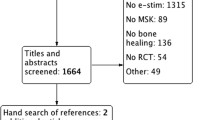Summary
The clinical application of the electrical stimulation, lasting several weeks, for the callus formation is reported in 11 patients. Bipolar rectangular pulse sequences were used for the stimulation at a frequency of 1 Hz and a current intensity of ± 20 μamp.
The electrical stimulation was successfully employed after distraction osteotomies with a KDA-apparatus in shortening of the leg provoked by different causes or in the treatment of pseudarthroses.
The realignment of the newly formed callus and the osseous consolidation are stimulated and speeded up by he bipolar rectangular pulse sequences as it is also shown in the light of the roentgenograms of a case.
Zusammenfassung
Bei 11 Patienten wird der klinische, mehrwöchige Einsatz der Elektrostimulation mit bipolaren Rechteckimpulsfolgen mit einer Frequenz von 1 Hz and einer Stromstärke von ± 20 μamp zur Anregung der Kallusbildung beschrieben.
Nach Distraktionsosteotomien mit KDA-Anlagen bei bestehender Beinverkürzung verschiedener Genese oder bei der Therapie der Pseudarthrose fand dieses Verfahren der Elektrostimulation erfolgreich Anwendung.
Die Ausrichtung des neugebildeten Kallus und ossäre Konsolidierung werden durch die bipolaren Rechteckimpulsfolgen, wie auch Röntgenbilder einer Kasuistik zeigen, angeregt und beschleunigt.
Similar content being viewed by others
References
Anisimow AJ (1974) Action of direct current on bone tissue. Byull Eksp Biol Med 78:100–102
Bauer H, Kinzel L, Wolter D (1974) Untersuchungen zur Knochenbruchheilung unter Einfluß von elektrischem Gleichstrom. Z Orthop 112:402–407
Basset CA, Pawluk RJ (1972) Electrical behaviour of cartilage during loading. Science 178:982–983
Black J, Friedenberg ZB, Brighton CT (1974) Growth response of intact bone to direct current and pulsed current. Proc Conf Eng Med Biol 16:250
Brighton CT, Friedenberg ZB, Mitchell EJ, Booth RE (1977) Treatment of nonunion with constant direct current. Clin Orthop Rel Res 124:106–123
Cieszynski T (1967) Electric factor in bone regeneration. Report on studies in vitro and in vivo. Symp Biol Hung 7:269–273
Friedenberg ZB, Brighton CT (1966) Bioelectric potentials in bone. J Bone Jt Surg 48-A:915–923
Güttler P, Kleditzsch J (im Druck) Die Anregung der Kallusbildung durch Interferenzströme. Deut Gesundheitswesen
Jörgensen TE (1977) Electrical stimulation of human fracture healing by means of a slow pulsating, asymmetrical direct current. Clin Orthop Rel Res 124:124–127
Jumaschew GS, Kojukow BN, Kotschetkow JT, Mordninow WJ, Smirnow EP (1975) Possibilities of the use of electrical stimulation of osteogenesis, in the treatment of patients with trochanteric fractures of the femur. Orthop Traumatol 2:49–51
Kraus W (1973) Theorie und tierexperimentelle Ergebnisse der elektrodynamischen Knochenbruchheilung. Nova Acta Leopoldina 44:119–126
Landa WA, Poljakow AN, Baranow WK (1976) Über die Wirkung des pulsierenden elektrischen Stromes auf die reparative Regeneration des Knochengewebes. Orthop Traumatol 10:55–59
Lavine LS, Lustrin J, Shamos MH (1977) Treatment of congenital pseudarthrosis of the tibia with direct current. Clin Orthop Rel Res 124:69–74
Lochner F (1973) Klinische Ergebnisse der elektrodynamischen Knochenbruchheilung. Nova Acta Leopoldina 44: 127–142
Nöh E (1970) Tierexperimentelle Studio zur Knochenneubildung durch elektrische Reizung. Verh Dent Orthop Traumatol Ges 57:133–138
Roessler H (1977) Physikalische und morphologische Untersuchungen zum Elektrokallus. Orthopäd Praxis X111:434 -436
Romano RL, Burgess EM, Rubenstein CP (1976) Percutaneous electrical stimulation for clinical tibial fracture repair. Clin Orthop Rel Res 114:290–295
Satzger G, Herbst E (1977) External fixation and electrical stimulation in 4 cases of congenital Tibia Pseudarthrosesan alternative to amputation. Vortrag zur 5. Internationalen Tagung des Fixateur externe. Budapest, 21.9.-22.9.
Sidschanow SchM, Schabanow AM, Parmursin LG, Scharmagambotow ChS, Sadikow RG (1976) Über die Anwendung elektrischen Stromes bei der Beschleunigung der Knochenheilung. Orthop Traumatol 10:64
Täger KH (1975) Anwendung elektrodynamischer Wechselpotentiale in der operativen und konservativen Orthopädie. Münch Med Wochenschr 117:791–798
Weigert M, Müller J (1970) Die Beeinflussung der Knochenbruchheilung durch Gleich- und Wechselstrom. Verb Dent Orthop Traumatol Ges 57:129–133
Yasuda J (1977) Fundamental aspects of fracture treatment. Clin Orthop Rel Res 124:5–8
Zichner L (1978) Electrical stimulation in the treatment of pseudarthrosis. Vortrag zum 8. Internationalen Symposium über spezielle Probleme der Orthopädie vom 26. bis 28. Januar in Luzern
Author information
Authors and Affiliations
Additional information
Dipl.-Ing. H. Berndt, vorm. Technische Hochschule Ilmenau, Biomed. Fakultät, Sektion TBK, Fachbereich biomed. Technik und Bionik (Direktor: Prof. Forth)
Rights and permissions
About this article
Cite this article
Hellinger, J., Kleditzsch, J. Electrical stimulation of the callus formation by means of bipolar rectangular pulse sequences. Arch. Orth. Traum. Surg. 96, 241–246 (1980). https://doi.org/10.1007/BF00432861
Received:
Accepted:
Issue Date:
DOI: https://doi.org/10.1007/BF00432861




